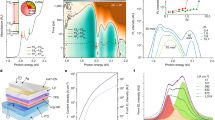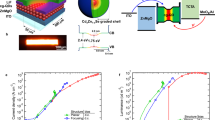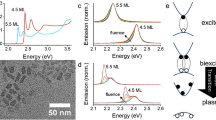Abstract
Colloidal quantum dots (QDs) raise more and more interest as solution-processable and tunable optical gain materials. However, especially for infrared active QDs, optical gain remains inefficient. Since stimulated emission involves multifold degenerate band-edge states, population inversion can be attained only at high pump power and must compete with efficient multi-exciton recombination. Here, we show that mercury telluride (HgTe) QDs exhibit size-tunable stimulated emission throughout the near-infrared telecom window at thresholds unmatched by any QD studied before. We attribute this unique behaviour to surface-localized states in the bandgap that turn HgTe QDs into 4-level systems. The resulting long-lived population inversion induces amplified spontaneous emission under continuous-wave optical pumping at power levels compatible with solar irradiation and direct current electrical pumping. These results introduce an alternative approach for low-threshold QD-based gain media based on intentional trap states that paves the way for solution-processed infrared QD lasers and amplifiers.
This is a preview of subscription content, access via your institution
Access options
Access Nature and 54 other Nature Portfolio journals
Get Nature+, our best-value online-access subscription
$29.99 / 30 days
cancel any time
Subscribe to this journal
Receive 12 print issues and online access
$259.00 per year
only $21.58 per issue
Buy this article
- Purchase on Springer Link
- Instant access to full article PDF
Prices may be subject to local taxes which are calculated during checkout




Similar content being viewed by others
References
Yin, Y. & Alivisatos, P. Colloidal nanocrystal synthesis and the organic-inorganic interface. Nature 437, 664–670 (2005).
Kovalenko, M. V. et al. Prospects of nanoscience with nanocrystals. ACS Nano 9, 1012–1057 (2015).
Keuleyan, S., Lhuillier, E., Brajuskovic, V. & Guyot-Sionnest, P. Mid-infrared HgTe colloidal quantum dot photodetectors. Nat. Photon. 5, 489–493 (2011).
Bao, J. & Bawendi, M. G. A colloidal quantum dot spectrometer. Nature 523, 67–70 (2015).
Wang, X. et al. Tandem colloidal quantum dot solar cells employing a graded recombination layer. Nat. Photon. 5, 480–484 (2011).
Kim, T. et al. Full-colour quantum dot displays fabricated by transfer printing. Nat. Photon. 5, 176–182 (2011).
Beard, M. C. et al. Comparing multiple exciton generation in quantum dots to impact ionization in bulk semiconductors: implications for enhancement of solar energy conversion. Nano Lett. 10, 3019–3027 (2010).
Galland, C. et al. Two types of luminescence blinking revealed by spectroelectrochemistry of single quantum dots. Nature 479, 203–207 (2011).
De Geyter, B. et al. The different nature of band edge absorption and emission in colloidal PbSe/CdSe core/shell quantum dots. ACS Nano 5, 58–66 (2011).
Norris, D. J., Efros, A. L. & Erwin, S. C. Doped nanocrystals. Science 319, 1776–1779 (2008).
Aubert, T. et al. Homogeneously alloyed CdSeS quantum dots: an efficient synthesis for full optical tunability. Chem. Mater. 25, 2388–2390 (2013).
Nurmikko, A. What future for quantum dot-based light emitters? Nat. Nanotech. 10, 1001–1004 (2015).
Jenkins, A. Silicon lasers: the final frontier. Nat. Photon. 1, 240 (2007).
Simply silicon. Nat. Photon. 4, 491 (2010).
Chen, R. et al. Nanolasers grown on silicon. Nat. Photon. 5, 170–175 (2011).
Wang, Z. et al. Room temperature InP DFB laser array directly grown on (001) silicon. Nat. Photon. 9, 837–842 (2015).
Franzo, G., Priolo, F., Coffa, S., Polman, A. & Carnera, A. Room-temperature electroluminescence from Er-doped crystalline Si. Appl. Phys. Lett. 64, 2235–2237 (1994).
Daldosso, N. et al. Erbium and silicon nanocrystals for light amplification. Conf. Proc.—Lasers and Electro-Optics Society Annual Meeting-LEOS 933–934 (2007).
Geiger, R. et al. Analysis of enhanced light emission from highly strained germanium microbridges. Nat. Photon. 7, 466–472 (2013).
Xie, W. et al. On-chip integrated quantum-dot silicon-nitride microdisk lasers. Adv. Mater. 29, 1604866 (2017).
Klimov, V. I. et al. Optical gain and stimulated emission in nanocrystal quantum dots. Science 290, 314–317 (2000).
Klimov, V. I. et al. Single-exciton optical gain in semiconductor nanocrystals. Nature 447, 441–446 (2007).
Dang, C. et al. Red, green and blue lasing enabled by single-exciton gain in colloidal quantum dot films. Nat. Nanotech. 7, 335–339 (2012).
Schaller, R. D., Petruska, M. a. & Klimov, V. I. Tunable near-infrared optical gain and amplified spontaneous emission using PbSe nanocrystals. J. Phys. Chem. B 107, 13765–13768 (2003).
Grim, J. Q. et al. Continuous-wave biexciton lasing at room temperature using solution-processed quantum wells. Nat. Nanotech. 9, 891–895 (2014).
Klimov, V. I. Quantization of multiparticle auger rates in semiconductor quantum dots. Science 287, 1011–1013 (2000).
Chen, Y. et al. Flexible distributed-feedback colloidal quantum dot laser. Appl. Phys. Lett. 99, 241103 (2011).
García-Santamaría, F. et al. Suppressed auger recombination in ‘giant’ nanocrystals boosts optical gain performance. Nano Lett. 9, 3482–3488 (2009).
Fan, F. et al. Continuous-wave lasing in colloical quantum dot solids enabled by facet-selective epitaxy. Nature 544, 75–79 (2017).
Caruge, J. M., Halpert, J. E., Wood, V., Bulović, V. & Bawendi, M. G. Colloidal quantum-dot light-emitting diodes with metal-oxide charge transport layers. Nat. Photon. 2, 247–250 (2008).
Keuleyan, S., Kohler, J. & Guyot-Sionnest, P. Photoluminescence of mid-infrared HgTe colloidal quantum dots. J. Phys. Chem. C 118, 2749–2753 (2014).
Keuleyan, S., Lhuillier, E. & Guyot-Sionnest, P. Synthesis of colloidal HgTe quantum dots for narrow mid-IR emission and detection. J. Am. Chem. Soc. 133, 16422–16424 (2011).
Kim, S. et al. Bandgap engineered monodisperse and stable mercury telluride quantum dots and their application for near-infrared photodetection. J. Mater. Chem. 21, 15232–15236 (2011).
Allan, G. & Delerue, C. Tight-binding calculations of the optical properties of HgTe nanocrystals. Phys. Rev. B 86, 165437 (2012).
Keuleyan, S. E., Guyot-sionnest, P., Delerue, C. & Allan, G. Mercury telluride colloidal quantum dots: electronic structure, size-dependent spectra, and photocurrent detection up to 12 μm. ACS Nano 8, 8676–8682 (2014).
Hens, Z. & Moreels, I. Light absorption by colloidal semiconductor quantum dots. J. Mater. Chem. 22, 10406–10415 (2012).
Kittel, C. Introduction to Solid State Physics (John Wiley, 2005).
Jiang, S. B. et al. Er3+-doped phosphate glasses for fiber amplifiers with high gain per unit length. J. Non-Cryst. Solids 263, 364–368 (2000).
Pietryga, M. et al. Spectroscopic and device aspects of nanocrystal quantum dots. Chem. Rev. 116, 10513–10622 (2016).
Geiregat, P., Allan, G., Hens, Z. & Delerue, C. Single-exciton optical gain in semiconductor nanocrystals: positive role of electron-phonon coupling. Phys. Rev. B 93, 115416 (2016).
Viswanatha, R., Brovelli, S., Pandey, A., Crooker, S. & aKlimov, V. I. Copper-doped inverted core/shell nanocrystals with ‘permanent’ optically active holes. Nano Lett. 11, 4753–4758 (2011).
Boehme, S. C. et al. Density of trap states and Auger-mediated electron trapping in CdTe quantum-dot solids. Nano Lett. 15, 3056–3066 (2015).
De Roo, J., Van Driessche, I., Martins, J. C. & Hens, Z. Colloidal metal oxide nanocrystal catalysis by sustained chemically driven ligand displacement. Nat. Mater. 15, 517–521 (2016).
Hassinen, A. et al. Short-chain alcohols strip X-type ligands and quench the luminescence of PbSe and CdSe quantum dots, acetonitrile does not. J. Am. Chem. Soc. 134, 20705–20712 (2012).
Anderson, N. C., Hendricks, M. P., Choi, J. J. & Owen, J. S. Ligand exchange and the stoichiometry of metal chalcogenide nanocrystals: spectroscopic observation of facile metal-carboxylate displacement and binding. J. Am. Chem. Soc. 135, 18536–18548 (2013).
Houtepen, A., Hens, Z., Owen, J. S. & Infante, I. On the origin of surface traps in colloidal II–VI semiconductor nanocrystals. Chem. Mater. 29, 752–761 (2017).
Kim, T.-H. et al. Full-colour quantum dot displays fabricated by transfer printing. Nat. Photon. 5, 176–182 (2011).
Kwak, J. et al. Bright and efficient full-color colloidal quantum dot light-emitting diodes using an inverted device structure. Nano Lett. 12, 2362–2366 (2012).
Perdew, J. P., Burke, K. & Ernzerhof, M. Generalized gradient approximation made simple. Phys. Rev. Lett. 77, 3865–3868 (1996).
Iannuzzi, M., Schiffmann, F. & Vandevondele, J. CP2k: atomistic simulations of condensed matter systems. Wiley Interdiscip. Rev. Comput. Mol. Sci. 4, 15–25 (2014).
Acknowledgements
This research is funded by Ghent University (Special Research Fund BOF), BelSPo (IAP 7.35, photonics@be), EU-FP7 (Navolchi), NWO (Vidi grant, No. 723.013.002) Horizon 2020 ITN Phonsi and ERC-ULPICC and ERC-PoC Interdot. P.G. acknowledges the FWO Vlaanderen for a postdoctoral fellowship. S. Flamee is acknowledged for TEM imaging of the QDs and R. Van Deun and P. Smet are acknowledged for the use of the steady-state and time-resolved photoluminescence set-up and the cryogenic spectroscopy, respectively.
Author information
Authors and Affiliations
Contributions
P.G. carried out the steady-state and time-resolved photoluminescence, and the ultrafast experiments, analysed the data, aided in theory development and wrote the manuscript; A.J.H. supervised the experiments, aided in theory discussions and wrote the manuscript; I.I. and F.Z. performed the DFT calculations and wrote the manuscript; L.K.S. synthesized the HgTe QDs and performed structural characterization (TEM, XRD); C.D. and G.A. carried out the tight-binding simulations and aided in theory development; D.V.T. aided in theory discussions and supervised the research; Z.H. initiated and supervised the research, aided in the theory development and wrote the manuscript.
Corresponding author
Ethics declarations
Competing interests
The authors declare no competing financial interests.
Supplementary information
Supplementary Information
Supplementary Information (PDF 2021 kb)
Rights and permissions
About this article
Cite this article
Geiregat, P., Houtepen, A., Sagar, L. et al. Continuous-wave infrared optical gain and amplified spontaneous emission at ultralow threshold by colloidal HgTe quantum dots. Nature Mater 17, 35–42 (2018). https://doi.org/10.1038/nmat5000
Received:
Accepted:
Published:
Issue Date:
DOI: https://doi.org/10.1038/nmat5000
This article is cited by
-
Very long wave infrared quantum dot photodetector up to 18 μm
Light: Science & Applications (2024)
-
Optical gain and lasing from bulk cadmium sulfide nanocrystals through bandgap renormalization
Nature Nanotechnology (2023)
-
Synthesis and optical properties of II–VI semiconductor quantum dots: a review
Journal of Materials Science: Materials in Electronics (2023)
-
Electroluminescence from nanocrystals above 2 µm
Nature Photonics (2022)
-
Ultrastable low-cost colloidal quantum dot microlasers of operative temperature up to 450 K
Light: Science & Applications (2021)



